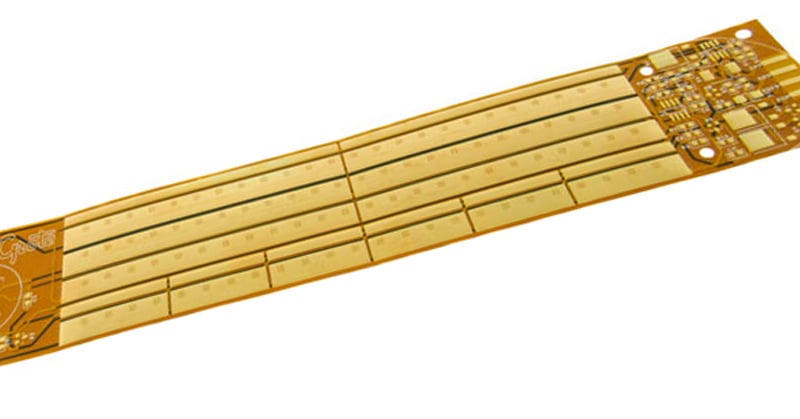In the realm of electronics design, especially when dealing with Gerber files for flexible circuit board layouts, engineers continually seek innovative solutions to combat electromagnetic interference (EMI). Shielding is a pivotal strategy in this battle, serving not just to protect sensitive components but also to ensure the integrity and performance of the electronic device as a whole.
This post delves into the practicalities of implementing various shielding methods into your Gerber designs, aiming to simplify what might initially appear as a daunting task.
Copper Shields: The Simple Yet Effective Approach
Starting with copper shields, this method stands out for its simplicity and ease of implementation. By adding two external layers as copper pours to your existing design, you create an effective barrier against EMI. This process is universally supported across CAD systems, making it an accessible option for designers. However, it's essential to incorporate additional vias for circuit routing to surface mount technology (SMT) components on these external shield layers, ensuring they remain accessible from the internal layers.

Flexible printed circuit board with a copper shield.
Despite its benefits, PCB designers must be cautious with via stitching in flex areas to avoid compromising design flexibility, especially since the IPC 2223C standards advise against excessive via use in flexible PCB designs due to potential reliability concerns.
Pros of Copper Layers:
- Peak Effectiveness: Copper stands out as the premier material for EMI shielding. Its application in the form of solid planes offers unmatched shielding efficacy, making it the gold standard in the industry.
- Controlled Impedance Mastery: For designs necessitating precise impedance control, copper layers are indispensable. Their conductivity and shielding capabilities ensure signal integrity across various applications.
- Versatility Across Designs: Whether you're working with high-density component areas, flex circuits, or rigid-flex configurations, copper layers adapt seamlessly. Their ability to form tight ground pours around surface mount components enhances their utility in complex designs.
Cons of Copper Layers:
- Cost and Flexibility Impact: The inclusion of copper layers increases both the physical thickness and stiffness of flex circuits, compromising flexibility. Additionally, the cost implications cannot be overlooked, as each added layer escalates production expenses, posing challenges for designs exceeding two layers.
Silver Ink Shields: Navigating Complexities with Precision
Transitioning to silver ink shields, the complexity significantly increases. The lack of widespread CAD system support for this method adds a layer of challenge. Silver ink acts as an additional coverlay but requires much larger tolerances.
Key considerations include oversizing openings by at least 0.020” to accommodate process and material tolerances and maintaining a minimum line width of 0.050” to avoid crowding between components. Designers must also ensure a setback from the part outline to prevent silver ink exposure, crucial for the shield's effectiveness and durability.
Given these complexities, it's common for designers to seek professional assistance in integrating silver ink shields into their designs, though this can lead to disconnection from the CAD database, potentially complicating future revisions.
Pros of Silver Ink:
- Cost-Effective Shielding: While slightly less effective than copper, silver ink is a proven, less expensive alternative for EMI shielding. Its inherent flexibility makes it a suitable option for designs prioritizing bend capability.
- Decades of Reliability: Having been employed for decades, the traditional method of using silver ink for shielding speaks volumes about its reliability and effectiveness in certain applications.
Cons of Silver Ink:
- Manufacturing Complexity: The application of silver ink introduces additional steps and materials, increasing the complexity and thickness of the flex circuit. This method is not recommended for controlled impedance designs, where it necessitates a broader impedance tolerance.
- Becoming Obsolete: As a result of shielding films, silver ink has gone to the wayside. Many manufacturers can no longer support silver ink, as the extra manufacturing steps required are no longer cost effective to meet the demand for silver ink.
Shielding Films: A Balanced Solution
Shielding films represent a middle ground between the simplicity of copper layers and the complexity of silver ink. Treated as a secondary coverlay or a mechanical layer, this method requires additional oversizing of openings compared to the primary coverlay and attention to maintaining minimum web thickness.
Ideally, shields extend to the part outline to simplify the manufacturing process and ensure alignment across all layers. This method is particularly beneficial in rigid-flex designs, where epoxy strain reliefs help create a seamless transition and seal at the flex-to-rigid areas. However, PCB designers should be wary of the added manufacturing cost and complexity when opting to "postage-stamp" shields into place for small or intricately shaped areas.
Pros of Shielding Films:
- Cost-Effective and Flexible: Shielding films offer an attractive balance between effectiveness, cost, and application ease. They are particularly suited for non-controlled impedance designs, providing significant advantages in terms of manufacturing simplicity and material cost.
- Diverse Material Options: Manufacturers like Tatsuta offer a wide array of shielding films, catering to various design requirements and enhancing the designer's toolkit with materials boasting different thicknesses and shielding properties.
Cons of Shielding Films:
- Limited in Controlled Impedance Designs: Similar to silver ink, shielding films are less ideal for controlled impedance applications, requiring adjustments in tolerance levels. Their application also poses challenges in high-density component areas due to material thickness and web limitations.
Practical Considerations and Best Practices
When incorporating shielding into your designs, consider the following best practices:
- Compatibility with CAD Systems & Manufacturing: Ensure your chosen shielding method is supported by your CAD system and PCB manufacturer to streamline the design process.
- Design Flexibility vs. Shielding Effectiveness: Balance the need for design flexibility with the effectiveness of your shielding strategy, especially in flex circuit designs.
- Manufacturing Tolerances: Account for process and material tolerances, especially with silver ink shields, to ensure the shield's integrity and performance.
- Cost vs. Benefit Analysis: Evaluate the cost implications of your shielding method against its benefits in terms of EMI protection and device performance.
Summary
Whether you opt for copper shields, silver ink, or shielding films, the key to success lies in understanding the nuances of each method and selecting the one that best fits your design requirements and constraints. With careful planning and execution, you can effectively integrate shielding into your Gerber designs, enhancing the performance and reliability of your electronic devices.
Key Takeaways
- Copper shields are the most effective option for EMI protection, offering peak shielding and controlled impedance performance, but they add stiffness, thickness, and cost to flex designs.
- Silver ink shields are flexible and cost-effective, but they require larger tolerances, are less precise for impedance-controlled applications, and are gradually becoming obsolete in favor of films.
- Shielding films strike a balance between performance, cost, and manufacturability, making them well-suited for non-impedance-controlled designs and rigid-flex configurations.
- Manufacturing and CAD compatibility matter, but not all CAD tools support silver ink, and improper design practices like excessive via stitching in flex areas can compromise reliability.
- Best results come from planning trade-offs, so designers should weigh shielding effectiveness, design flexibility, and cost implications when choosing between copper, silver ink, or films for their PCB layout.
















